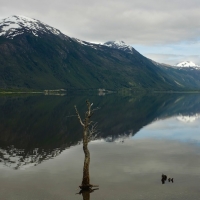 It is dead quiet, very dark and it is freezing! Although I am wearing a woollen hat and I lie in a liner and a down sleeping bag, I have woken up a few times from the cold. I could not bring myself to get out of my warm sleeping bag to put on extra clothes, but now I have woken up again I see no other solution. I get out of my sleeping bag and find an extra pair of trousers and a pair of thick socks. The extra clothes are very cold at first, but once I am back in the sleeping bag, it quickly becomes comfortably warm. When I wake up again, it is light. “Cold huh?!” I hear from the sleeping bag next to me. This was without doubt the coldest night so far. Our sleeping bags are quite thick, but if it gets any colder, they are not warm enough. And it is very well possible that we will have some colder nights, because we are still a long way from the southernmost point of our trip. From here we will go another 1,000 km further south.
It is dead quiet, very dark and it is freezing! Although I am wearing a woollen hat and I lie in a liner and a down sleeping bag, I have woken up a few times from the cold. I could not bring myself to get out of my warm sleeping bag to put on extra clothes, but now I have woken up again I see no other solution. I get out of my sleeping bag and find an extra pair of trousers and a pair of thick socks. The extra clothes are very cold at first, but once I am back in the sleeping bag, it quickly becomes comfortably warm. When I wake up again, it is light. “Cold huh?!” I hear from the sleeping bag next to me. This was without doubt the coldest night so far. Our sleeping bags are quite thick, but if it gets any colder, they are not warm enough. And it is very well possible that we will have some colder nights, because we are still a long way from the southernmost point of our trip. From here we will go another 1,000 km further south.
We stay in our sleeping bags like Eskimos for a while, blowing clouds of steam to the roof of the tent. When we hear the first cars on the road next to us, we get out of our beds and start packing our stuff. After a hot coffee and a full breakfast, we are ready to go.
I turn the ignition of my motorbike and press the start button, but nothing happens: the battery of my bike is empty! During the trip it has happened a number of times that the battery was completely empty, because I had left the headlight on for too long or because we had charged stuff on the bike when it was not running.  Last night we charged the intercom of the helmet and apparently that was too much for my already bad battery in this cold weather. We push the bike over the meadow to the road and then up the hill. Peter sits on my bike while I push him down the road until he has enough momentum to bump start the bike. The first time the bike does not start, so we have to push it up the hill again for a second attempt. It is just a small, light motorbike, but with all the luggage is still quite a job to push it up the hill. The second time it does start and we -now with red cheeks of pushing the bike- can hit the road.
Last night we charged the intercom of the helmet and apparently that was too much for my already bad battery in this cold weather. We push the bike over the meadow to the road and then up the hill. Peter sits on my bike while I push him down the road until he has enough momentum to bump start the bike. The first time the bike does not start, so we have to push it up the hill again for a second attempt. It is just a small, light motorbike, but with all the luggage is still quite a job to push it up the hill. The second time it does start and we -now with red cheeks of pushing the bike- can hit the road.
We drive the scenic road through the valley of the Rio Exploradores back to Puerto Rio Tranquilo and continue our journey to the south along Lago General Carrera. The weather is beautiful and the sun is already warm. The lake is fed by melt water from the Northern Patagonian Icefield, which gives the water an almost unreal blue colour. From the lake we drive into the mountains, up over a pass, and on the other side of the mountain range into the valley of the Rio Baker. Just like the lake the river has a special light blue colour. The river squeezes through the narrow valley with thundering violence, creating white caps on the water. it must be quite an adventure to be in a kayak on this river.
 At the end of the gorge the valley becomes more wide. From the road we have a stunning view over the light blue river in the depths of the valley and the road that runs parallel to the river as a thin line across the slope toward the horizon. We follow the road and arrive in Cochrane at the end of the afternoon. It is one of the last large towns we will visit on the Carretera Austral. We find a place to sleep at Hostal Central, a small hostel that was recommended to us by Matthew and Megan. Not because of the comfy beds or the fast internet, but because the owner: the friendly Trudy.
At the end of the gorge the valley becomes more wide. From the road we have a stunning view over the light blue river in the depths of the valley and the road that runs parallel to the river as a thin line across the slope toward the horizon. We follow the road and arrive in Cochrane at the end of the afternoon. It is one of the last large towns we will visit on the Carretera Austral. We find a place to sleep at Hostal Central, a small hostel that was recommended to us by Matthew and Megan. Not because of the comfy beds or the fast internet, but because the owner: the friendly Trudy.
We ring the bell, but know-one answers the door. The hostel seems to be closed. Just as we want to leave, a taxi stops in front of the hostel. A grey lady with a friendly face gets out of the car and places two suitcases in front of the door. Trudy! She explains that she went to Santiago two weeks ago, just after our South African friends left, for a hospital visit and that the hostel had been closed all this time. It is meant to be that she arrives back home right now. She opens the door and welcomes us. We take one of the double rooms and appreciate the hot shower even more after our cold adventure last night.
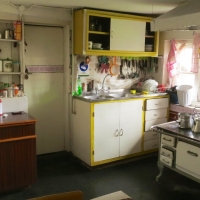 When we wake up the next morning, the weather is bad. It is raining and it is quite a few degrees colder than yesterday. Inside the hostel it is not much warmer. The cottage is made of wood and not very well insulated. Trudy does not seem to be bothered by the cold and walks around in a t-shirt on her flip-flops. It is summer after all! But the Patagonian summer is even for us Dutchmen quite chilly. Wearing a thick sweater we sit down at the kitchen table, the only place in the house where it is warm. And that heat comes from the stove. It is not a gas-stove like we use at home, but a wood stove. In fact, it is like a large wood burner, with a big iron plate with room for pans. It looks a bit old-fashioned, but is still very ’modern’ here. In almost every house you can find such a wood-burning stove. And although more and more people switch to a modern gas-stove or convert their old wood-stove to gas, these kind of stoves are still sold. Especially in the Patagonian winter the heat coming from the stove is very important. It takes some getting used to and it is a little slower than cooking on gas, but works just fine!
When we wake up the next morning, the weather is bad. It is raining and it is quite a few degrees colder than yesterday. Inside the hostel it is not much warmer. The cottage is made of wood and not very well insulated. Trudy does not seem to be bothered by the cold and walks around in a t-shirt on her flip-flops. It is summer after all! But the Patagonian summer is even for us Dutchmen quite chilly. Wearing a thick sweater we sit down at the kitchen table, the only place in the house where it is warm. And that heat comes from the stove. It is not a gas-stove like we use at home, but a wood stove. In fact, it is like a large wood burner, with a big iron plate with room for pans. It looks a bit old-fashioned, but is still very ’modern’ here. In almost every house you can find such a wood-burning stove. And although more and more people switch to a modern gas-stove or convert their old wood-stove to gas, these kind of stoves are still sold. Especially in the Patagonian winter the heat coming from the stove is very important. It takes some getting used to and it is a little slower than cooking on gas, but works just fine!
We decide to stay an extra day with Trudy, hoping that the bad weather will blow over. We use our “free day” to do laundry, to work on the blog and again for some maintenance on the bikes. Trudy indeed is a very friendly lady. Although we do not speak each other’s language, we do manage to chat with her. She tells us about her family, her grandchildren, the hostel and the harsh winters in Patagonia. It is like we are staying with our ‘granny’, not in the last place because of the lovely vegetable soup that is on the stove.
When it stops raining that afternoon, we walk around in the village to do some shopping. Though you can not really say we walk ’round’, because it is more like we walk a ‘square’. The village seems to have been designed on a drawing board, because all the streets are straight and equally far apart. It is like a grid, with between the streets large squares with one or more houses.  Almost all towns and cities where we have been so far, from Buenos Aires in Argentina to Puerto Tranquilo in Chile, are designed in the same way. To us it feels somewhat unnatural, but it sure is easy to find your way. If someone explains us where to go, he will say: “Five blocks straight ahead and then two blocks to the left.” No weird Y-junctions or “follow the road when it turns to the right” like we are used to in Holland, but simply counting blocks and you will get there.
Almost all towns and cities where we have been so far, from Buenos Aires in Argentina to Puerto Tranquilo in Chile, are designed in the same way. To us it feels somewhat unnatural, but it sure is easy to find your way. If someone explains us where to go, he will say: “Five blocks straight ahead and then two blocks to the left.” No weird Y-junctions or “follow the road when it turns to the right” like we are used to in Holland, but simply counting blocks and you will get there.
And all towns and cities have one more thing in common: they all have at least one “plaza”. A square in the center of the village with a park and in the middle a statue of the local hero. Often there are some benches in the park where villagers meet. In Cochrane the “Plaza de Armas” even has free wifi! Spread over the villages are little shops everywhere. Often mini-supermarkets that are run from a house and where anything and everything is sold. We can go there for bread and fresh vegetables, but also for toilet paper or clothespins. The biggest difference with the supermarkets in the cities is that the small neighbourhood supermarkets offer less choice. There will only be one kind of jam or only one type of spaghetti.
On the central square in Cochrane we stand in front of a window of a large store. With open mounds of amazement we look at the combination of stuff they offer for sale in the shop window: tools, fishing tackles, dog food, knitting wool, guitars, ballet shoes, wood stoves and nail polish! Once in the store, we are even more surprised as to what we see. It is just a small store, but it is packed with absolutely everything that you can possibly need in the Patagonian wilderness. In one corner are tools, next tot that outboard engines and even guns. In the middle is a small supermarket with some fresh fruit and vegetables. 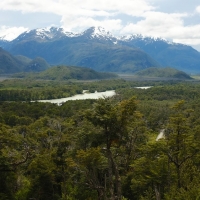 At the left they sell clothes but also fabric and wool, all kinds of school supplies, musical instruments and medals that can be used at a sporting event. In the back of the store we see bed frames, as well as the stoves that Trudy also uses in the hostel. We are so impressed with all the stuff that we first walk around for a while before we begin to fill our shopping cart.
At the left they sell clothes but also fabric and wool, all kinds of school supplies, musical instruments and medals that can be used at a sporting event. In the back of the store we see bed frames, as well as the stoves that Trudy also uses in the hostel. We are so impressed with all the stuff that we first walk around for a while before we begin to fill our shopping cart.
After a quiet evening in the kitchen of the hostel, the next morning we pack our bags. The weather has improved and the rain has stopped. We say goodbye to Trudy and get on the bikes for the last stretch of the Carretera Austral to Villa O’Higgins.
Once we leave the village, we are right back in the wilderness. As far as we can see there is a dense forest. High green trees on the slopes and in the valley a river. In the distance we see high mountain ridges with a thick layer of snow on the top, that get closer during the day. The gravel road is in good condition and with gentle curves great to ride. There is hardly any other traffic on the road and we see almost no houses. From Cochrane we do pass some farms, but spread over 100km we count only a handful. The farmhouses we do see, are small one man businesses like we saw earlier along the route. Next to most houses are several horses, sometimes saddled and ready to go back to work. In this landscape a horse will sometimes be much more convenient than a car or a tractor.
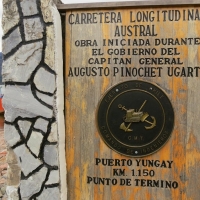 At the beginning of the afternoon we arrive in Puerto Yungay, a hamlet with only a few houses. The houses are built on a hill overlooking the water. Although we are far inland and it seems like we overlook a large lake, we are again at the sea. On the waterfront we see a dark edge that indicates the difference between high and low tide. For a long time Puerto Yungay was the end of the Carretera Austral. Access to the far south of Chile was only possible with the permission and assistance of the Chilean army. In the little harbour a sign even mentions that the Carretera Austral stops here after 1.150km. But that is history, because the route was extended in 2000 when a road was constructed to Villa O’Higgins. In order to get onto that new road we will have to cross the fjord from Puerto Yungay with a ferry that is still run by the Chilean army.
At the beginning of the afternoon we arrive in Puerto Yungay, a hamlet with only a few houses. The houses are built on a hill overlooking the water. Although we are far inland and it seems like we overlook a large lake, we are again at the sea. On the waterfront we see a dark edge that indicates the difference between high and low tide. For a long time Puerto Yungay was the end of the Carretera Austral. Access to the far south of Chile was only possible with the permission and assistance of the Chilean army. In the little harbour a sign even mentions that the Carretera Austral stops here after 1.150km. But that is history, because the route was extended in 2000 when a road was constructed to Villa O’Higgins. In order to get onto that new road we will have to cross the fjord from Puerto Yungay with a ferry that is still run by the Chilean army.
Against our expectation there already is a ferry in the harbour when we arrive. We drive to the entrance of the boat, but just when we want to drive onto the boat a man that is on the boat starts waving and gestures us to stop. At that moment the ferry starts to move backwards. The man points to a truck with gasoline that is on the ferry and shouts: “No personas.” We cannot take this ferry. Then he points to his watch and makes clear that the next ferry leaves in about four hours. Wow, we will have to wait quit some time so we best make ourselves comfortable. Peter gets our e-readers out and on the sidewalk next to the bike I light the gas stove to make a cup of coffee.
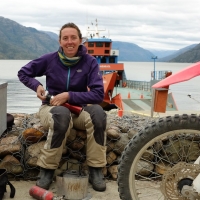 While we sit in a small waiting room drinking our coffee and reading a book, four cyclists arrive in the harbour. A couple from New Zealand and a couple from Germany, all with fully packed bicycles. We had overtaken them earlier that day on the way to the boat. They are not the first cyclists we see, because the Carretera Austral is a particularly popular cycle route. Every day we pass at least a few cyclists, some on their own, others as a couple and even families with children! And the cyclists are of all ages, the couple from New Zealand has just retired and a cyclist from Germany who we met in Puerto Varas was almost 70. We already think it is an adventure to drive the Carretera Austral, but for the cyclists this is definitely so. On the motorbikes a distance of 100km to the next village is only a couple of hours away, but for cyclists such a distance can easily be three days on this gravel road through the hills. They cannot stay at a campsite every day and should bring enough food and water for a few days to a week. In addition, the road leads through a hilly area with some steep climbs and the weather can change quickly. On a bicycle this might very well be an even bigger adventure.
While we sit in a small waiting room drinking our coffee and reading a book, four cyclists arrive in the harbour. A couple from New Zealand and a couple from Germany, all with fully packed bicycles. We had overtaken them earlier that day on the way to the boat. They are not the first cyclists we see, because the Carretera Austral is a particularly popular cycle route. Every day we pass at least a few cyclists, some on their own, others as a couple and even families with children! And the cyclists are of all ages, the couple from New Zealand has just retired and a cyclist from Germany who we met in Puerto Varas was almost 70. We already think it is an adventure to drive the Carretera Austral, but for the cyclists this is definitely so. On the motorbikes a distance of 100km to the next village is only a couple of hours away, but for cyclists such a distance can easily be three days on this gravel road through the hills. They cannot stay at a campsite every day and should bring enough food and water for a few days to a week. In addition, the road leads through a hilly area with some steep climbs and the weather can change quickly. On a bicycle this might very well be an even bigger adventure.
Not long after the cyclists, a motorcycle is parked next to our bikes. We meet Stuart and Nicola from England. They bought a motorcycle in the U.S. and left for a trip of more than six months through the ‘Americas’. It is very nice to hear about their journey, especially since they come from the north and can tell us about the countries where we are going after Chili. We ask most travelers we meet what the best or most beautiful country was they visited. In Africa the answer usually was Namibia (because of the amazing nature) and Malawi (for its friendly people). Here in South America Colombia seems to be the most favorite travel destination. We are curious to find out!
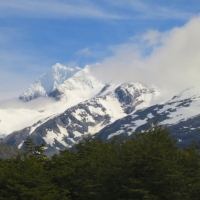 Mid-afternoon the ferry is back in the harbour and we can get onboard. We stay with the bikes and chat with Nicola and Stuart about our mutual adventures. Crossing the fjord takes an hour, but we are having so much fun that we are across before we even know it. From the ferry we both go our own way. We would like to camp in the woods near Villa O’Higgins tonight, but our new friends do not have camping gear and will go to the center of the village to find a hostel. We exchange email addresses and agree to try to meet again further south.
Mid-afternoon the ferry is back in the harbour and we can get onboard. We stay with the bikes and chat with Nicola and Stuart about our mutual adventures. Crossing the fjord takes an hour, but we are having so much fun that we are across before we even know it. From the ferry we both go our own way. We would like to camp in the woods near Villa O’Higgins tonight, but our new friends do not have camping gear and will go to the center of the village to find a hostel. We exchange email addresses and agree to try to meet again further south.
The scenery is incredibly beautiful, with rugged mountains, blue-white glaciers, deep gorges and beautiful lakes. Real wilderness! We both think of the movie “Into the Wild.” Just like in Alaska, where that film takes place, you could easily ’disappear’ in Patagonia. It is 90km from the ferry to the end of the Carretera Austral. Although the ‘new’ road on the other side of the fjord is in good condition, our average speed on these kind of gravel roads, especially with photo stops along the way, is not more than 40km per hour. It therefore takes at least another two hours before we arrive at Villa O’Higgins. Although we start our trip at the end of the day, we do not have to be afraid that we will be driving in the dark, because the days are very long here in the south. According to the GPS, the sun will only set at a quarter to ten tonight.
 At half past nine we find a camping spot just before the village on the bank of a wide river. We wait until all the cars that were on the ferry with us have past and then pitch our tent. While I cook a quick meal, Peter tests the fishing waters. As soon as the sun has disappeared behind the high peaks, it directly is a few degrees colder in the valley. Especially the wind blowing from the direction of the Southern Patagonian Icefield is bitterly cold. The further the sun goes down, the more beautiful the colour of the sky becomes. First pink and purple, but then bright yellow and orange, with some baby blue. We have already seen some beautiful sunsets, but this one is exceptional! We stay outside until the sun has completely disappeared and then take our plate of food in the tent, away from the cold and the cloud of mosquitoes that was buzzing around our heads.
At half past nine we find a camping spot just before the village on the bank of a wide river. We wait until all the cars that were on the ferry with us have past and then pitch our tent. While I cook a quick meal, Peter tests the fishing waters. As soon as the sun has disappeared behind the high peaks, it directly is a few degrees colder in the valley. Especially the wind blowing from the direction of the Southern Patagonian Icefield is bitterly cold. The further the sun goes down, the more beautiful the colour of the sky becomes. First pink and purple, but then bright yellow and orange, with some baby blue. We have already seen some beautiful sunsets, but this one is exceptional! We stay outside until the sun has completely disappeared and then take our plate of food in the tent, away from the cold and the cloud of mosquitoes that was buzzing around our heads.
With the cold night still fresh in our memories, we both put on some more clothes in our sleeping bags this time. And that turns out to be just right, because we both fall asleep quickly, without waking up again from the cold. The next morning the sun is up again very early. With a t-shirt over our faces we try to keep out the light, but in the end we just get up early. We freshen up with a splash of water in our faces and then have breakfast. It promises to be a beautiful sunny day, though right now it still is quite chilly in the shade. After breakfast, when everything is packed, we are back on the bike at half past eight.
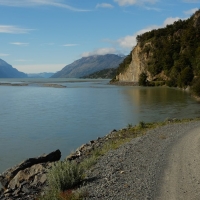 We drive into the centre of Villa O’Higgins, a small village with no more than 600 inhabitants. The end of the Carretera Austral is a few kilometers outside the village in Bahia Bahamondes, a small harbour on Lake O’Higgins. We drive along the edge of the lake on a road that is barely wide enough for one car. Not a problem, because there is no other traffic. Just outside the centre we reach the end of the Carretera Austral after 1,247 km! Literally the end, because the road stops in the harbour at the entrance to the ferry. For the cyclists we met earlier, this is not yet the end of their adventure in Chile. In Bahia Bahamondes they can take the ferry to the other side of the lake from where they can cross into Argentina. An adventurous journey on a path across the mountains, where they have to push their bikes in some parts because cycling against the steep slope is not possible. Unfortunately we cannot take that route with the fully packed bikes, so we have to turn around here and go back to Cochrane. We will cross back into Argentina just south of Cochrane, the most southern crossing we can take with the motorbikes.
We drive into the centre of Villa O’Higgins, a small village with no more than 600 inhabitants. The end of the Carretera Austral is a few kilometers outside the village in Bahia Bahamondes, a small harbour on Lake O’Higgins. We drive along the edge of the lake on a road that is barely wide enough for one car. Not a problem, because there is no other traffic. Just outside the centre we reach the end of the Carretera Austral after 1,247 km! Literally the end, because the road stops in the harbour at the entrance to the ferry. For the cyclists we met earlier, this is not yet the end of their adventure in Chile. In Bahia Bahamondes they can take the ferry to the other side of the lake from where they can cross into Argentina. An adventurous journey on a path across the mountains, where they have to push their bikes in some parts because cycling against the steep slope is not possible. Unfortunately we cannot take that route with the fully packed bikes, so we have to turn around here and go back to Cochrane. We will cross back into Argentina just south of Cochrane, the most southern crossing we can take with the motorbikes.
In the harbour we park our bikes next to the sign of the Carretera Austral for an official portrait and then we start our journey to the north again. If we leave now we will have enough time to drive back to the “military ferry” which leaves at eleven. It is still early and the light is particularly beautiful. The lake we pass is as smooth as a mirror reflecting the white peaks perfectly. At some parts the road goes right through the swamp. As a biologist you can really have some fun here because in one square meter you should be able to find numerous different plants. On the way back to the boat we cross the four cyclists again that we met on the ferry yesterday. 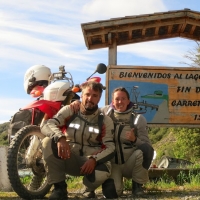 From the point where they left the ferry, they cycled 25 km before pitching their tent yesterday. From this point it is still more than 60 km to Villa O’Higgins, a distance they will cover in two days. What a difference with our ‘day trip’.
From the point where they left the ferry, they cycled 25 km before pitching their tent yesterday. From this point it is still more than 60 km to Villa O’Higgins, a distance they will cover in two days. What a difference with our ‘day trip’.
It is chilly on the ferry, so we take a seat inside the waiting area while we slowly sail back to Puerto Yungay. On the other side of the lake we give the cars a head start, before we also take off. We drive back the same route, but although we have been here before it is again very beautiful. We do not drive directly back to Cochrane, but leave the main road to go to Caleta Tortel. It is a small village on the coast that for a long time was only accessible by sea or air, because there was no road to the village. Only in 2003 a road was built from the Carretera Austral to the town, making the village now accessible with a car (or motorcycle). However, the residents still cannot park their cars in front of their homes, because in the village are no streets! The houses are built on the steep slopes of a fjord and connected by wooden ramps and stairs. Even with a bicycle you cannot drive around the village. We park the motorbikes on the outskirts of the village and then walk down the stairs and follow the ramps for a tour around the centre. Very special!
 From Caleta Tortel we continue towards Cochrane at the beginning of the afternoon. Just before Cochrane we pass a sign that points to a campsite. We had read good stories about that place and decide to have a look. If it is not any good, we can always ride to Trudy. We follow the narrow path through a beautiful forest, along the banks of the Rio de los Nadis. It is quite a challenge to get to the campsite. The road crosses the land of a number of farms so, just like in Namibia, we need to get off the bikes a number of times to open and close the gates. We zigzag between cows, cross a super cool suspension bridge and follow a narrow path into the valley. Turning around to go to Trudy is not so simple any more.
From Caleta Tortel we continue towards Cochrane at the beginning of the afternoon. Just before Cochrane we pass a sign that points to a campsite. We had read good stories about that place and decide to have a look. If it is not any good, we can always ride to Trudy. We follow the narrow path through a beautiful forest, along the banks of the Rio de los Nadis. It is quite a challenge to get to the campsite. The road crosses the land of a number of farms so, just like in Namibia, we need to get off the bikes a number of times to open and close the gates. We zigzag between cows, cross a super cool suspension bridge and follow a narrow path into the valley. Turning around to go to Trudy is not so simple any more.
After 10 kilometres of obstacles we encounter on our last hurdle: a fence that surrounds a large group of sheep. The beasts are clearly put there by the farmer with the intention of holding them there. Now opening the gate does not seem such a good idea. Behind the sheep we see some people, but they do not seem to know we are here. I climb over the fence, walk through the group of sheep and climb over the fence again. Just behind the barn I meet the farmer and his family. After a hard day of work they sit down in the grass with a cold drink. The campsite is open and we are very welcome!
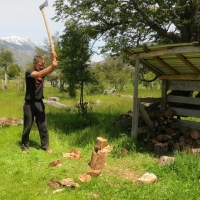 The farmer’s wife leads us to the campsite, which is a little away from their house. It is a beautiful place in the valley of the Rio de los Nadis from where we have a 360-view of snow-capped mountains and glaciers. There is no electricity, not even in the house, but there is a hot shower, a kitchen with wood stove and a fireplace. As in Hornopiren, she advises us to to light a fire that evening to keep warm. She shows us where the wood is and points Peter to the ax. Not long after, Peter is diligently chopping wood. And although it is indeed pretty chilly that night, we did not feel cold!
The farmer’s wife leads us to the campsite, which is a little away from their house. It is a beautiful place in the valley of the Rio de los Nadis from where we have a 360-view of snow-capped mountains and glaciers. There is no electricity, not even in the house, but there is a hot shower, a kitchen with wood stove and a fireplace. As in Hornopiren, she advises us to to light a fire that evening to keep warm. She shows us where the wood is and points Peter to the ax. Not long after, Peter is diligently chopping wood. And although it is indeed pretty chilly that night, we did not feel cold!
The next morning it is not a difficult decision: we are staying another day! While Peter takes his fishing rod to the river, I swap my bike for a horse! Along with the farmer’s wife and her daughter I make a trip of more than two hours on their land. We drive through the woods, cross little streams, ride along the cows and sheep and eat Calafate berries from the saddle. A great trip!
 The next day it is only a short ride back to Cochrane, where we already arrive at the end of the morning. We do shopping and after a quick lunch we start a new adventure: crossing back into Argentina via Nature Reserve Valle Chacobuco and crossing Paso Roballos. More on that in the next post!
The next day it is only a short ride back to Cochrane, where we already arrive at the end of the morning. We do shopping and after a quick lunch we start a new adventure: crossing back into Argentina via Nature Reserve Valle Chacobuco and crossing Paso Roballos. More on that in the next post!
Distance to Valle Chacabuco: 38,686 km (24,038 miles) of which 1,841 km on the Carretera Austral!
Previous story “Carretera Austral (Part I)” – Next story “The end of the world“





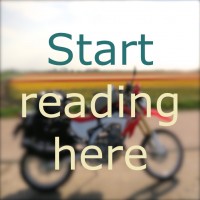


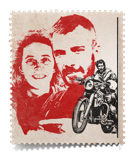
Hallo Leonie en Peter,
Verhalen blijven mooi. Lijkt net een aardrijkskundeles.
Je kunt alle reisverslagen in boekvorm uit gaan brengen. Goede reis verder en geniet. We blijven jullie volgen.
Ps: afgelopen week bijgepraat met je vader. Waren dus al van het een en ander op de hoogte.
Hoi Leonie en Peter, wat is het daar mooi!!
Liefs van ons xx
De eerste foto doet me sterk denken aan onze reis in Canada. De hartelijke groeten uit Groningen.